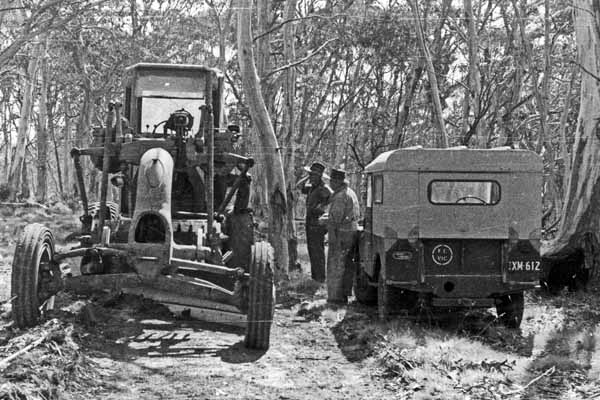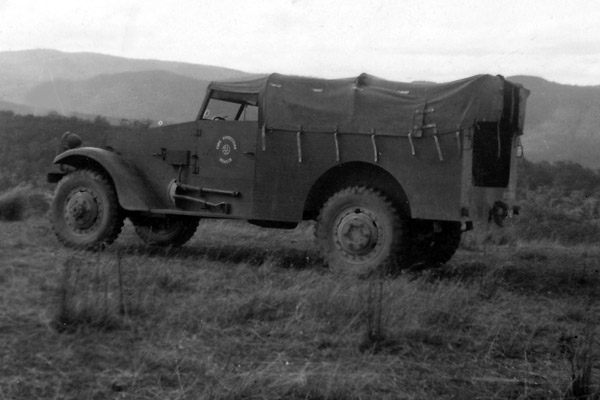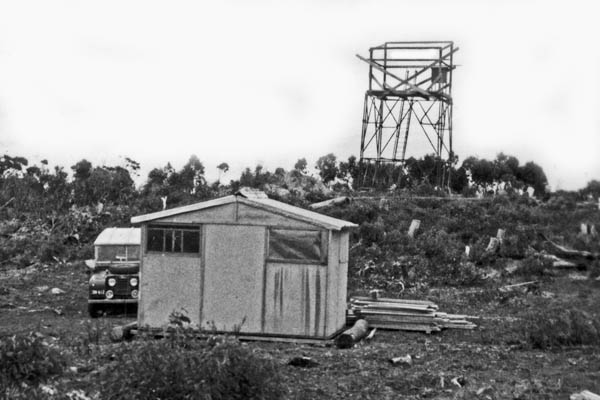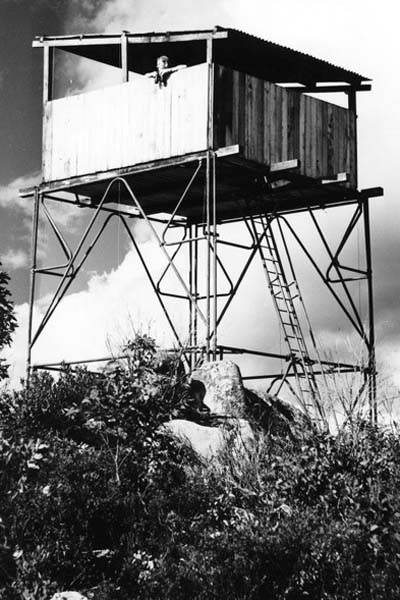The First Mt Nugong Fire Tower - Built 1954
A Hodgson
The FCV had acquired a decommissioned control tower from the RAAF at Bairnsdale Airfield, intending it to be erected on Mt Nugong. When I was posted to Bruthen in 1952, the dismantled tubular-steel scaffold, including some large welded sections, was stacked in the Depot yard together with a steel ladder and boxes of nuts, bolts, couplers, anchor ties and other items needed to re-assemble the tower. It did not include the air traffic controllers’ cabin.
Getting the over-size (12ft x 12ft) welded steel sections from Bruthen to the top of Mt Nugong posed several problems. A Morris two-wheel-drive tray-body truck with Police escort was used on the narrow and busy Omeo Highway as far as Ensay. Between Ensay and Bentley’s Plain the main hazard was from trees overhanging he narrow road on the Nunniong Plateau. A two-man Stihl chainsaw and an Allis Chalmers road grader fixed that problem.
Beyond Bentley’s Plain, a bulldozer, hired from a contractor who was snigging and loading sawlogs on the Plateau, was used to clear a new ‘jeep-track’ from a logging road to the top of Mt Nugong. The jeep track was suitable for four-wheel-drive vehicles but the steepest section just below the summit was too steep for any fully-loaded vehicle.
That particular problem was solved by hitching a wooden sledge behind a White Scout Car (both fully loaded) and towing them to the summit with the contractor’s bulldozer.
"The M3 Scout Car was manufactured by the White Motor Coy for the US Army. The M3A1 White Scout Car had a transfer case that did not allow disengagement of the front wheel drive. ie it was constant four-wheel drive but without a compensating differential or front drive shaft compensator, and thus was an absolute pain to drive on hard surfaces due to axle wind-up. 590 were delivered to Australia from the USA under Lend-Lease arrangements during 1942-43. The M3A1 had a conventionally aspirated 5.24 litre six-cylinder in-line side valve model JXD Hercules petrol engine coupled to a 4 forward/1 reverse gear box and a two-speed transfer case. Armour was ¼ inch thick except for the front windscreen plate which was ½ inch. The one pictured is a standard body Scout car but has had the rear panel cut out to make a door opening. Wheel base was 80 inches." (Source: Mike Cecil)
Heavy items were loaded on the Scout Car below the top of the armour. The large welded sections of scaffold were placed horizontally across the vehicle on top of each other and secured to the vehicle with ropes. The driver had to lower himself through the scaffold to drive it.
The sledge was hewn from a forked tree snigged to the site. The bottom and top sides of each fork (runners) were ‘squared’ with a broadaxe. A flat deck made of lengths of sawn 4 x 4 inch timber was fixed to the runners with bridge spikes to support and secure the load.
In addition to the steel scaffold, the loads included: cement, bags of aggregate and water in 44 gallon drums to make the concrete footings for the tower and the anchor points for steel cables that would secure the cabin and scaffold; sawn timber to build the cabin; a dismantled Stanley Hut for shelter; roofing iron and a tank to catch rainwater from the hut.
Putting all the bits and pieces together and securing them, including the cabin, took most of the summer. Except for a University Forestry student on vacation work and Bill Ah Chow, the work was done by Forests Commission personnel based at Bruthen. The tower survived two decades before a storm blew it down in 1974 - testament to the ingenuity of forestry gangs of that era.
It was also an era when Occupation Health and Safety and other issues were often overlooked. In this case, the logging contractor was happy to accept two boxes of gelignite, a box of detonators and some safety fuse in exchange for his help.

Jim Westcott (l) and Bill Ah Chow, 1953
Photo: A Hodgson

FCV Fire Protection Branch Scout Car (JP401) at Open Grounds, Mt Steatham (Nunnet)
Photograph taken in 1947
by J McKinty
Source: M McKinty

Mt Nugong Tower under construction, 1953
Photo: A Hodgson

Mt Nugong Tower in 1958
Photo: R Bailey, Source: A Hodgson
